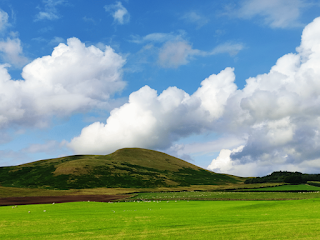The gate to Scottish Highlands Stirling
Central Scotland
Stirling, known as the coronation place of the Scottish kings, is in central Scotland. It is often called the gateway to the Highlands because the famous region of the Scottish Highlands begins not that far from there. The city is one of the most popular tourist destinations and in the past has even been the capital of Scotland. Stirling was established as a royal city in 1130, although people have inhabited this area for about four thousand years.
Stirling is around 25 miles north-east of Glasgow and less than 40 miles north-west of Edinburgh, forming a kind of a triangle on the map between these three Scottish cities; they are all well connected by modern motorways.
Although Stirling has city status, it is only nineteenth of the 51 towns and cities in Scotland with a population of less than 38,000.
Medieval Stirling castle and old town
As the city is not too big, the old town is not large too, however, Stirling Castle, which is located at the top of a steep volcanic rock and can be seen far from the surrounding plains, makes it impressive. There is even an old saying – who owns Stirling owns Scotland.
If you are travelling by car, there are parking places at a reasonable price available near the train station, close to the Vue Cinema (see the link to the route on the map further in text). You can, of course, park in the courtyard of the castle, however, the price will be much higher and there will not always be free parking spaces available. From the parking lots near the station, you can walk down the streets of the small city centre and walk up to the castle – it will not be too much effort, although the streets may sometimes be quite steep.
Wallace Monument
On the outskirts of Stirling, there is a monument, a symbol of Scottish history. The name Wallace may be familiar to many after the 1995 film The Braveheart, in which American actor Mel Gibson portrayed the historical image of the Scottish independence leader William Wallace.
For some time, a statue of an actor was even placed near the monument, but because of local opposition, it was removed. The main reason – the film is an artwork, and it cannot claim a full reflection of historical facts. And in the end, William Wallace was Scottish.
Some more tips if you are in Stirling
One of the largest institutions in the city is the University of Stirling, where I have worked for several years. Its reputation in some specific areas such as aquaculture is highly valued not only in the UK but also worldwide; students from all over the world go there to study. In fact, the university is not located in the city, but in its suburb town Bridge of Allan, about two and a half miles from the centre of Stirling.
The above-mentioned Wallace Monument is located right next to the university.
The above-mentioned Wallace Monument is located right next to the university.
Stirling has many places to eat and various accommodation opportunities. It must be said that there are a lot of Indian restaurants and not everyone may enjoy it, but without huge effort, it is possible to find other types of restaurants and cafes.
One of the restaurants I can recommend is right next to the castle – Port Cullis. It is a cosy restaurant bar, where you can sit both indoors and in a small garden, and the prices (in August 2021, when we were there) are reasonable considering the location. In any case, after visiting the castle, having lunch there can positively complement the impressions gained in the castle.
Other places of interest for travellers to Scotland in addition to the above are Edinburgh, Glasgow, Isle of Skye, Loch Lomond and Loch Ness, the Hebrides, and a range of national parks for those seeking physical activities.



